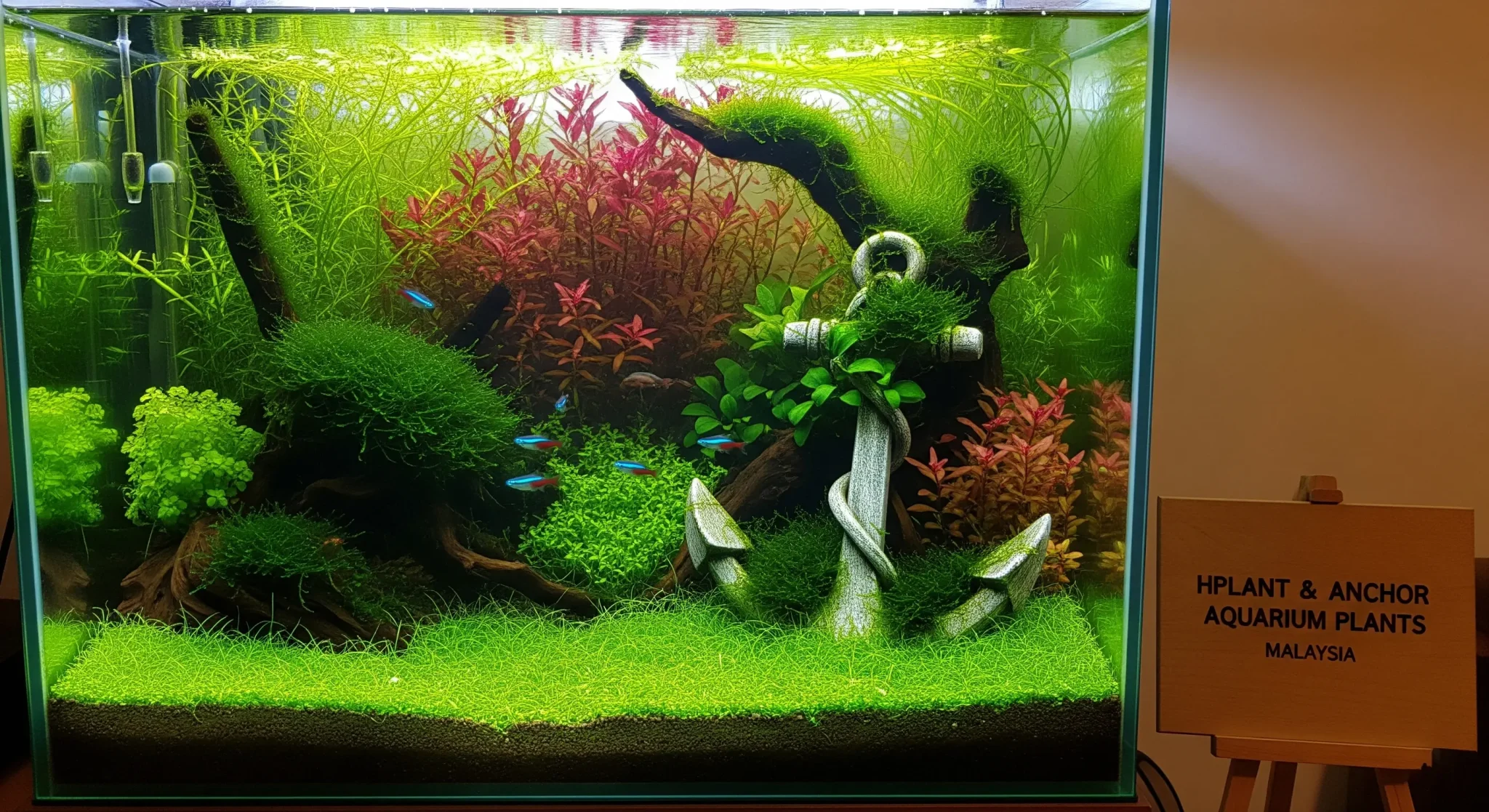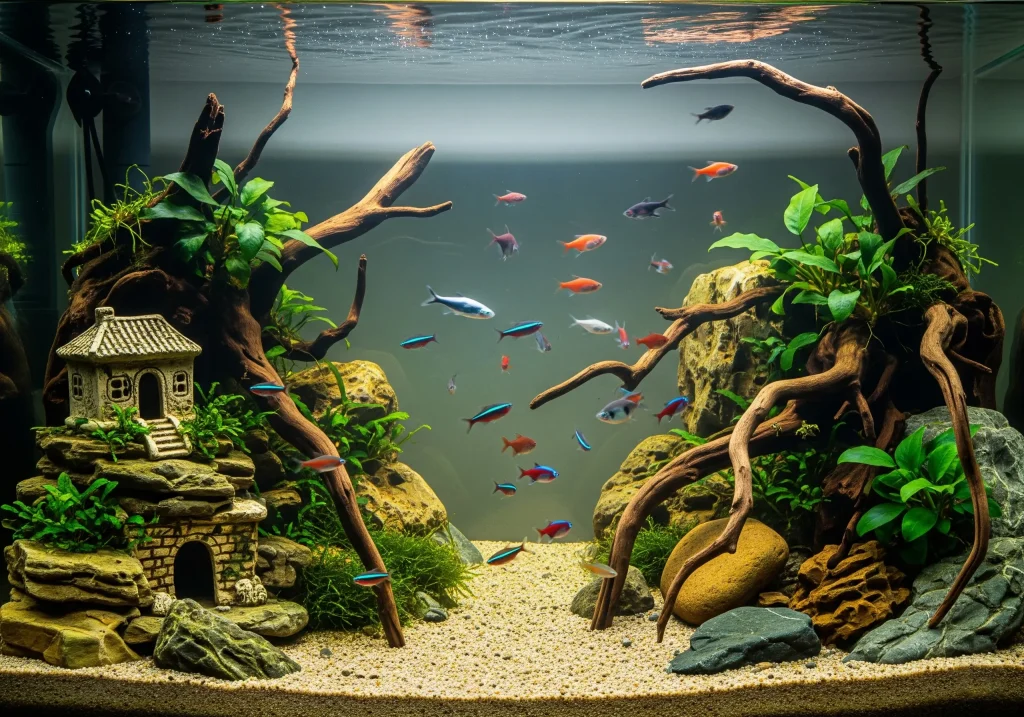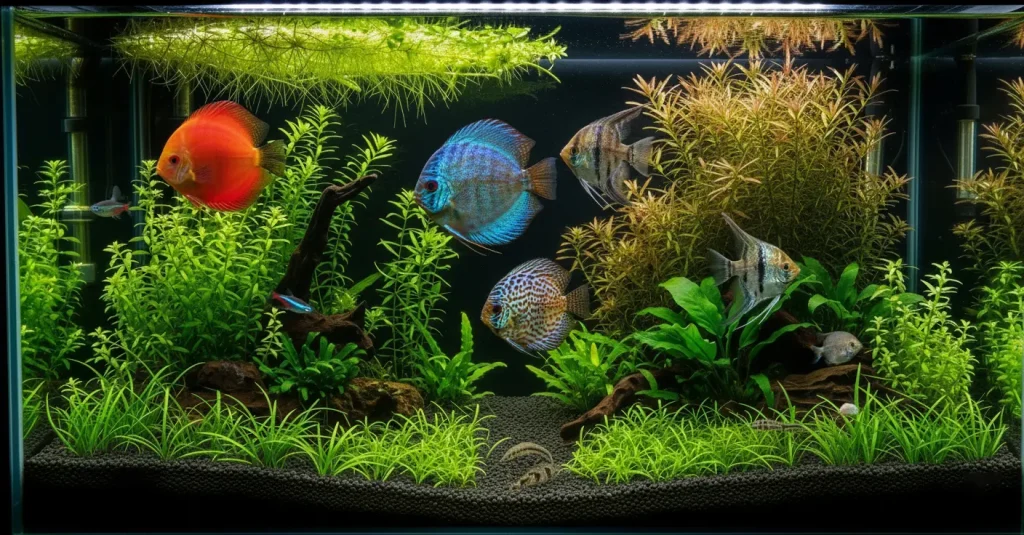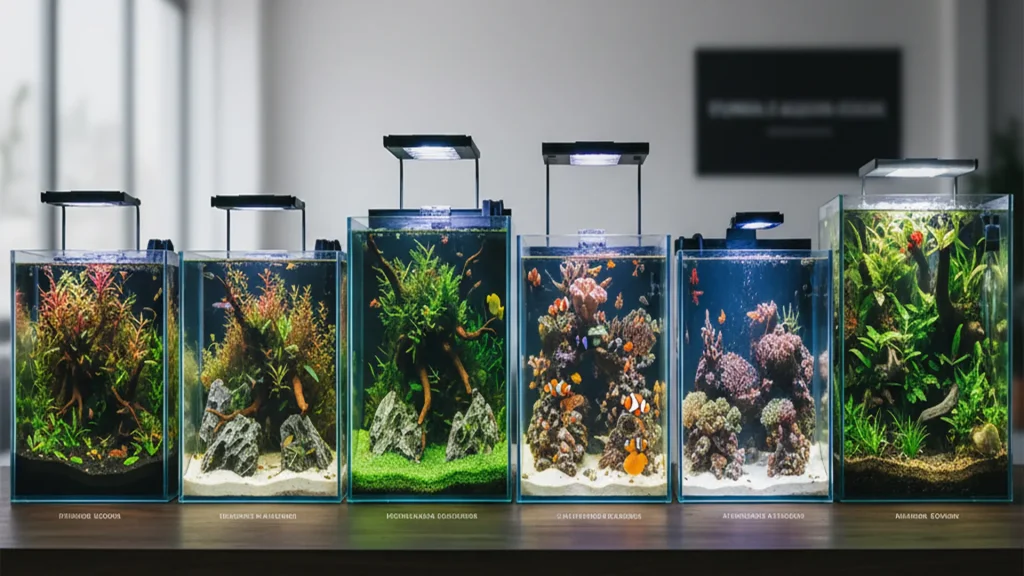Quick Answer: How to Plant Aquarium Plants Malaysia?
If you’re wondering how to plant aquarium plants Malaysia, the quick answer is simple: choose the right substrate (soil, gravel, or sand), place root feeders like Cryptocoryne and Amazon Sword with root tabs deep in the substrate, and tie or glue epiphytes like Anubias or Java Fern onto wood or rocks. Carpet plants require trimming and proper spacing, while floating plants only need gentle surface flow and occasional thinning.
Table of Contents
Why Proper Planting Matters (and Why Malaysia is Special)
This is why understanding how to plant aquarium plants Malaysia correctly is crucial for long-term success. When people think of aquarium plants, they often picture lush underwater jungles with healthy green leaves waving in the current. But here’s the truth: how you plant them in the very beginning decides whether they thrive or melt away.
In Malaysia, aquariums face unique conditions:
- Warm climate – Tropical temperatures can speed up plant growth but also algae.
- Tap water with chlorine/chloramine – Affects root development if not conditioned.
- Popular small tanks (2–3 ft) – Planting technique matters because space is limited.
When plants are correctly anchored, roots establish quickly, leaves stay intact, and nutrient uptake begins immediately. Poor planting leads to floating plants, rotting roots, and an endless cycle of frustration.
👉 Key takeaway: Planting is not just “stick it in the gravel.” It’s a skill — and in Malaysia’s climate, it’s a game-changer.
See also Aquarium Plants Malaysia (2025) for a full plant guide.
Tools You Need Before Planting
Before you dip your hands into the tank, prepare the right tools. It makes planting precise, reduces plant damage, and saves time.
Basic planting kit for aquascaping in Malaysia:
- Aquarium tweezers/forceps – For gripping and inserting delicate plants without crushing them.
- Aquarium scissors – For trimming carpet plants and removing melting leaves.
- Root tabs for aquarium plants Malaysia – Provide nutrients under heavy feeders (Cryptocoryne, Amazon Sword).
- Aquarium glue/gel (cyanoacrylate-based) – Safe for sticking Anubias, Bucephalandra, or Moss to rocks/wood.
- Aquarium-safe cotton thread or fishing line – For tying epiphytes until roots grip.
- Siphon and spray bottle – For water control during planting and keeping plants moist.
💡 Pro Tip: Many Malaysian aquascapers use chopsticks as budget tweezers when starting out — it works in a pinch, but proper tweezers make planting precise and less frustrating. This simple toolkit forms the basis of any aquarium planting guide Malaysia, whether you’re setting up a nano tank or a 4-foot planted aquarium. These simple tools are essential for anyone learning how to plant aquarium plants Malaysia with confidence.
Substrates: Soil vs Gravel vs Sand (Malaysia Context)
Your planting technique depends heavily on the substrate you choose. Choosing between sand, soil, or gravel is a big part of learning how to plant aquarium plants Malaysia the right way.
Aquarium Soil
- Nutrient-rich, designed for aquascaping.
- Ideal for root feeders and carpet plants.
- Example: ADA Amazonia, Tropica Soil, or locally available soils from Malaysia aquascape shops.
- Best for: Beginners who want fast growth, healthy carpets, and colorful plants.
Gravel
- Inert, contains no nutrients.
- Works as a base layer, but needs root tabs Malaysia for heavy feeders.
- Easy to clean, popular in fish-only tanks.
- Best for: Tanks focused on fish, with only low-maintenance plants (Anubias, Java Fern).
Sand
- Aesthetic, smooth, and safe for bottom-dwellers like Corydoras.
- Compacts easily, restricting root growth if not managed.
- Needs root tabs + careful planting to avoid suffocation.
- Best for: Decorative tanks with minimal planting or epiphyte-heavy setups.
👉 Malaysia-specific note: Many aquarists mix soil + sand/gravel layers to balance nutrients and aesthetics. Example: Soil in the back for stem plants, sand in the front for an open layout. The choice between aquarium plants in sand vs soil often depends on your goal — soil for growth, sand for aesthetics.
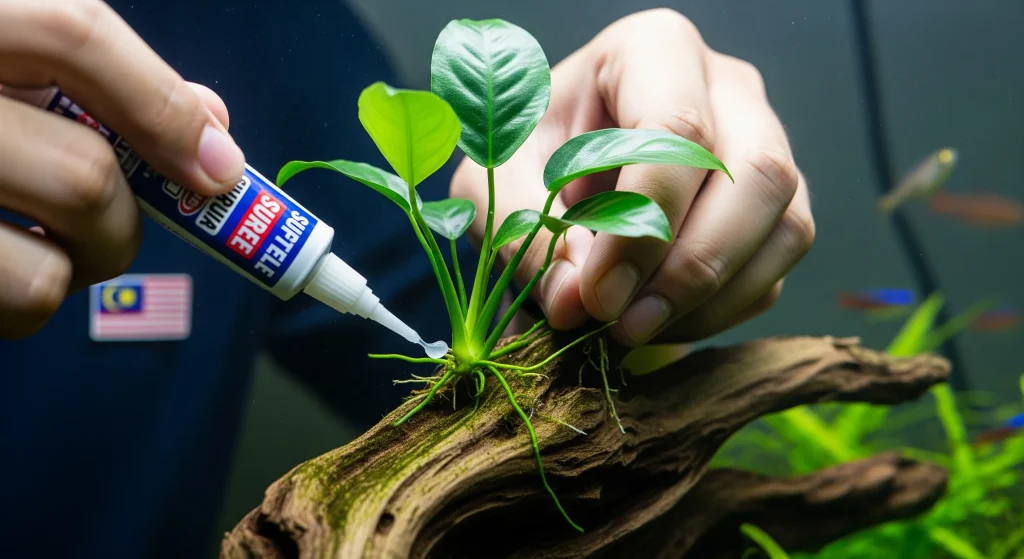
How to Plant Root-Feeding Aquarium Plants in Malaysia
Root-feeding plants — like Cryptocoryne, Amazon Sword, and Vallisneria — depend heavily on nutrients from the substrate. If planted incorrectly, they either float up or melt.
Step-by-step:
- Trim roots – Cut overly long roots to about 3–4 cm. This encourages fresh new growth.
- Use tweezers – Grip the plant at the base and insert into the soil at a 45° angle.
- Leave crown exposed – For plants like Cryptocoryne, burying the crown leads to rot.
- Add root tabs – Place root tabs Malaysia directly under the plant for long-term nutrition. You can refer to Tropica’s aquarium plant nutrition guide for professional recommendations.
- Spacing – Leave 5–10 cm between each plant to allow spread.
💡 Malaysian tip: Cryptocoryne is common in local aquascaping shops. Expect a “melt” phase after planting — leaves may disintegrate, but roots survive. Within 2–3 weeks, healthy new leaves will sprout.
For beginners, Cryptocoryne and Amazon Sword are perfect starter species when practicing how to plant aquarium plants Malaysia step by step.
How to Anchor Epiphytes (Anubias, Java Fern, Moss)
One of the most common beginner questions is how to anchor aquarium plants so they don’t float up after a few days. Epiphytes are plants that don’t need to be buried in soil. Instead, they anchor onto rocks, driftwood, or hardscape. Popular examples: Anubias, Java Fern, Bucephalandra, Moss (Java, Christmas, Flame).
Anchoring methods:
- Cotton thread or fishing line – Tie the plant gently onto driftwood/rock until roots attach.
- Superglue gel (aquarium-safe) – Apply a small dab at the rhizome and press onto hardscape. For a detailed anchoring tutorial, check 2Hr Aquarist’s guide on anchoring plants
- Mesh sheets for moss – Spread moss evenly on stainless steel/plastic mesh; over time it creates a lush carpet wall.
⚠️ Important: Never bury the rhizome of Anubias or Java Fern. It will rot. Keep it exposed to water flow.
💡 Malaysian context: Many local aquascapers use “mangrove driftwood” sold in Kepong and KL shops. Its rough texture is perfect for anchoring epiphytes.
Anubias and Java Fern make excellent teaching plants for anyone exploring how to plant aquarium plants Malaysia with hardscape anchoring methods.
How to Plant Carpet Plants in Aquariums
Carpet plants are what give tanks that “lush green field” look. Examples: Monte Carlo, Dwarf Hairgrass, Glossostigma. They require more patience and technique than other plants.
Planting method:
- Divide into small clumps – Break the plant tissue culture pot into 6–10 small pieces.
- Use tweezers – Insert each clump at a 45° angle, spacing about 2–3 cm apart.
- Trim leaves short – Helps encourage horizontal runners instead of vertical growth.
- Lighting – Keep lights at 6–8 hours/day; carpets need consistent intensity.
- CO₂ optional – Works faster with CO₂, but in low tech, combine with liquid fertilizer for aquarium plants to sustain slow growth.
💡 Prevent floating: After planting, lightly mist and cover with plastic wrap (“dry start method”) for 2–3 weeks before flooding. This helps roots grip firmly. If you follow this method, planting carpet plants aquarium becomes much easier, even without CO₂ injection.
Planting carpets is one of the trickiest parts of how to plant aquarium plants Malaysia, but it’s also the most rewarding.
👉 Aquascaping Malaysia (2025) has more on layouts with carpet plants.
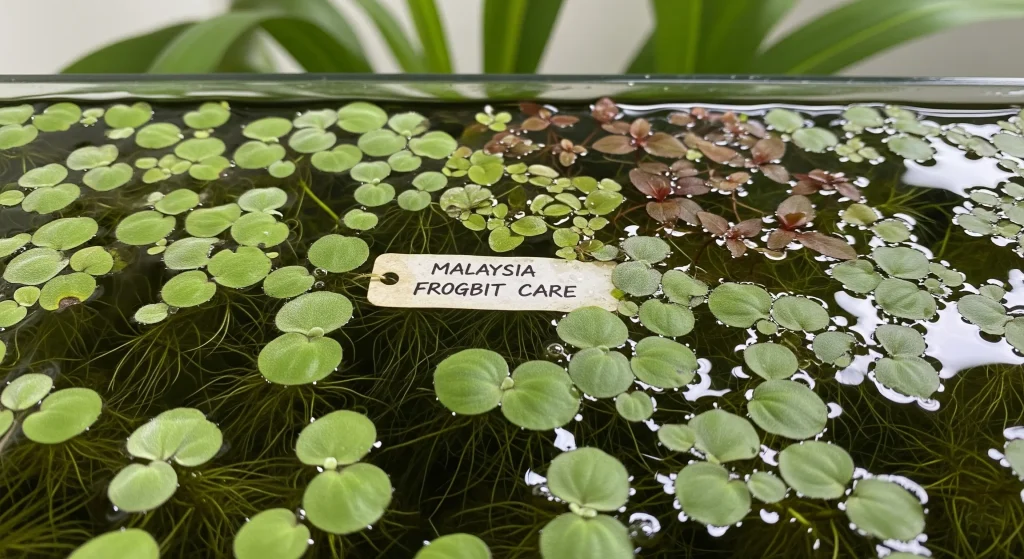
Floating Aquarium Plants: Care & Control in Malaysia
When discussing floating aquarium plants care Malaysia, the key is regular thinning and surface management to keep balance in the tank. Floating plants are popular in Malaysia because they’re easy, fast-growing, and great at nutrient absorption. Examples: Amazon Frogbit, Salvinia, Water Lettuce, Duckweed (hati-hati!).
Benefits:
- Provide shade, which helps prevent algae in planted tanks.
- Natural nitrate absorbers, reducing the need for heavy fertilizer dosing.
- Create a safe environment for fish fry and shy species.
Care tips for Malaysia:
- Humidity is already high, but avoid direct fan blowing at the surface.
- Thin weekly — floating plants can block all light if left unchecked.
- Rinse leaves during water changes to remove dust or algae film.
- Combine with aquarium fertilizer without CO₂ — since most floaters grow using atmospheric CO₂, they thrive even in low-tech setups.
💡 Pro Tip: Duckweed is common but invasive. If you’re not ready for constant scooping, choose Frogbit or Salvinia instead.
Using Root Tabs for Aquarium Plants in Malaysia
Root tabs are a game-changer for aquarists using sand or gravel substrates. Since these substrates lack nutrients, root tabs deliver food directly to root feeders.
How to use root tabs Malaysia:
- Insert 2–3 cm deep under the plant, not on the surface.
- Space about 5–8 cm apart in larger tanks.
- Replace every 4–6 weeks or when plant growth slows.
- Focus under heavy root feeders (Amazon Sword, Cryptocoryne, Vallisneria).
⚠️ Mistake to avoid: Don’t crush tabs before inserting. This releases nutrients too fast, fueling algae.
💡 Local note: Many aquarists in Kepong or KL shops use Seachem Flourish Tabs or DIY clay ball ferts. Both work well in Malaysian tanks.
Root tabs are a hidden secret in mastering how to plant aquarium plants Malaysia successfully in gravel or sand setups.
Common Planting Mistakes (and How to Avoid Them)
Even experienced hobbyists in Malaysia sometimes struggle with planting. Here are the most frequent issues:
- ❌ Burying crowns/rhizomes – Cryptocoryne crowns and Anubias rhizomes rot if buried.
- ❌ Planting too shallow – Plants float up after a few days; always insert deeper with tweezers.
- ❌ Crowding too close – Without spacing, roots compete, leaves block light.
- ❌ Skipping fertilizers – Relying only on fish waste is not enough. Add liquid fertilizer for aquarium plants + root tabs Malaysia.
- ❌ Too much light, too fast – High intensity without balanced nutrients = algae outbreak.
👉 Fix: Focus on balance — moderate lighting (6–8 hrs), consistent fertilizing, steady water changes.
See Aquarium Maintenance Malaysia (2025) for water change routines.
Malaysian Water Notes: What You Must Know Before Planting
Water in Malaysia is not the same everywhere — and it directly affects how your plants root and grow.
- Tap water (urban KL, Kepong, PJ) → Treated with chlorine/chloramine. Always use a water conditioner before planting or doing water changes.
- GH/KH levels → Moderate in most regions, but stability matters more than the exact number. Root feeders especially dislike sudden swings.
- Warm climate → Aquarium temperatures average 27–30°C. This speeds plant metabolism but also encourages algae, so keep lighting controlled (6–8 hrs).
- Seasonal rain (monsoon) → Can dilute tap water minerals slightly; monitor parameters if you do big water changes.
💡 Tip for Malaysians: Always keep an aquarium test kit handy. Stable conditions = happy roots, steady carpets, and zero algae headaches.
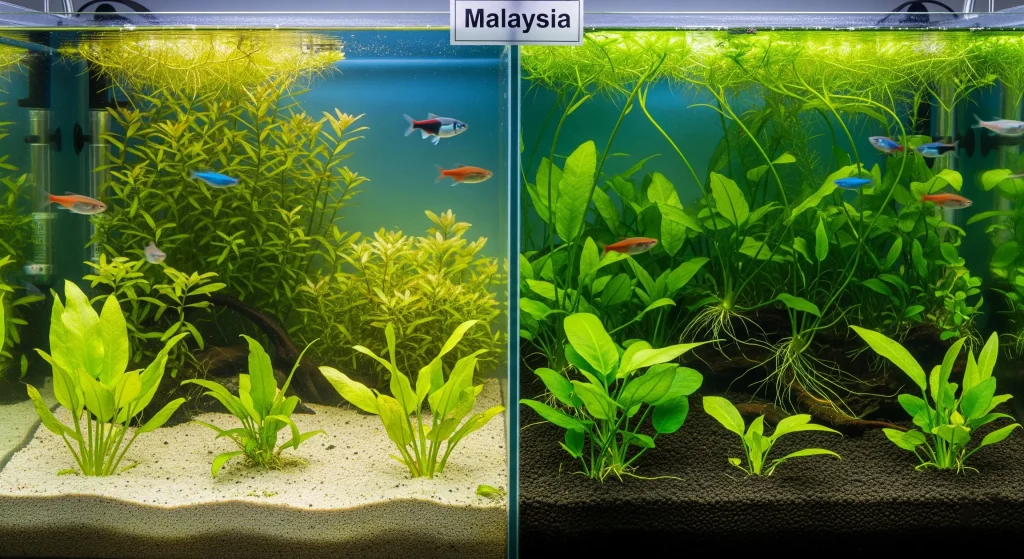
Case Study: 2-Foot Kepong Tank Planting Setup
To make this practical, let’s look at a real Malaysian beginner setup.
- Tank: 60 cm, low-tech, sponge filter, LED 7 hrs/day.
- Substrate: Gravel base + root tabs under root feeders.
- Plants used:
- Cryptocoryne wendtii (root feeder)
- Amazon Sword (heavy root feeder)
- Anubias nana (epiphyte)
- Monte Carlo (carpet)
- Salvinia (floating)
- Planting technique:
- Crypts trimmed and planted 3–4 cm deep with root tabs.
- Anubias glued to driftwood.
- Monte Carlo split into clumps, planted with tweezers.
- Salvinia thinned weekly.
- Results (after 6 weeks):
- Crypts recovered from melt with strong new leaves.
- Monte Carlo spreading slowly.
- Anubias rhizome attached to wood.
- No algae outbreak, just stable growth.
👉 Lesson: Even in Malaysia’s warm climate, balance + patience = success. This 2-foot Kepong tank is a textbook example of how to plant aquarium plants Malaysia in a low-tech setup.
See Custom Aquarium Malaysia (2025) if you want professional setup services.
FAQs: How to Plant Aquarium Plants in Malaysia (2025)
Q1: What’s the easiest way to plant aquarium plants Malaysia for beginners?
A: Start with root tabs under Cryptocoryne or Amazon Sword, glue Anubias onto wood, and use floating plants like Frogbit for quick success.
Q2: Do I need CO₂ to grow aquarium plants in Malaysia?
A: No. Many species thrive with just liquid fertilizer for aquarium plants and root tabs. CO₂ only speeds growth and enables carpets/red plants. For beginners, Tropica’s low-tech planting tips are very helpful.
Q3: How do I anchor aquarium plants so they don’t float?
A: Use tweezers to plant deeper, glue epiphytes to hardscape, and space carpet plants so roots grip the substrate firmly.
Q4: Which floating aquarium plants are best for Malaysia?
A: Frogbit and Salvinia. They grow fast, absorb excess nutrients, and help prevent algae in planted tanks.
Q5: How often should I replace root tabs Malaysia?
A: Every 4–6 weeks, or when growth slows. Insert 2–3 cm deep under heavy feeders like Swords or Crypts.

